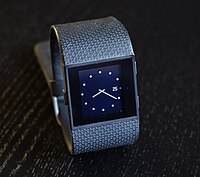
Photo from wikipedia
Background. Sleep and physical activity affect overall health. In youth with type 1 diabetes (T1DM), they may improve glycemic control. Data from low-income countries are lacking. Objective. To describe sleep… Click to show full abstract
Background. Sleep and physical activity affect overall health. In youth with type 1 diabetes (T1DM), they may improve glycemic control. Data from low-income countries are lacking. Objective. To describe sleep and activity in Haitian children and youth with T1DM, and examine their impact on glycemic control, health-related quality of life (HRQL), and life satisfaction (LS). Methods. This cross-sectional study in Haiti included people with T1DM aged 8–25 years. Wristbands (Mi Band 3) tracked activity (step count and activity time) and sleep (sleep duration, light sleep, and deep sleep). The Diabetes Quality of Life in Youth (DQOLY) questionnaire was used to evaluate HRQL and LS. Point-of-care (POC) hemoglobin A1c values were recorded. Linear regression was used to assess the relationship between sleep, activity, HbA1c, HRQL, and LS. Results. We included 66 participants (59% female, mean age 17.8 ± 4.8 years, mean diabetes duration 3.7 ± 3.4 years, and mean BMI Z-score −0.86 ± 1.1). Mean HRQL was 63/100, and mean LS was 65/100. Mean HbA1c was 11.3%. Maximum HbA1c measure was 14% on the POC machine, and 23 participants (35%) had HbA1c recorded as 14%. Mean daily step count was 7,508 ± 3,087, and mean sleep duration was 7 h31 ± 1 h17. When excluding participants with HbA1c ≥ 14%, shorter sleep duration was significantly associated with higher HbA1c ( p = 0.024 ). Sleep duration and step count were not associated with HRQL or LS. Conclusions. Children and youth with T1DM in Haiti have poor glycemic control and low HRQL and LS. Their sleep and activity habits are similar to peers. While activity did not affect HbA1c, HRQL, or LS, shorter sleep duration was associated with higher HbA1c in participants with HbA1c < 14%. Prospective studies with larger sample sizes are needed to validate our findings.
Journal Title: Pediatric Diabetes
Year Published: 2023
Link to full text (if available)
Share on Social Media: Sign Up to like & get
recommendations!